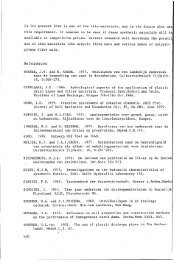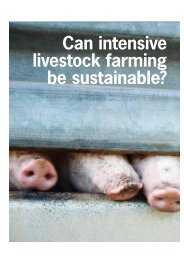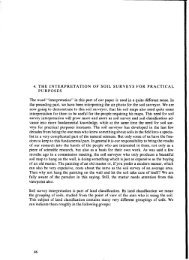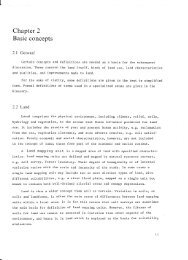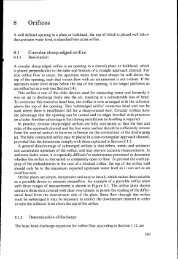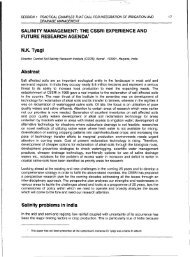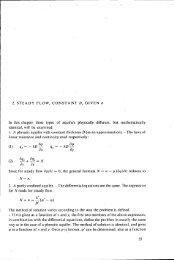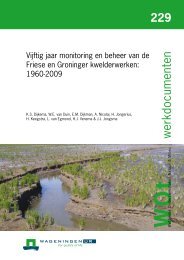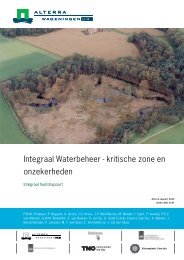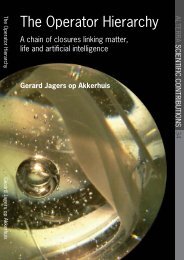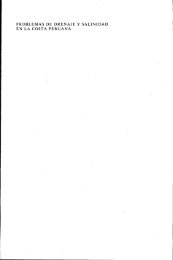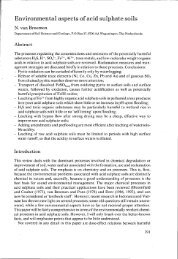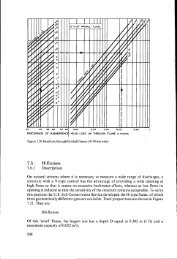SMALL-SCALE DREDGING AND DESILTING EQUIPMENT
SMALL-SCALE DREDGING AND DESILTING EQUIPMENT
SMALL-SCALE DREDGING AND DESILTING EQUIPMENT
You also want an ePaper? Increase the reach of your titles
YUMPU automatically turns print PDFs into web optimized ePapers that Google loves.
<strong>SMALL</strong>-<strong>SCALE</strong> <strong>DREDGING</strong><strong>AND</strong> <strong>DESILTING</strong> <strong>EQUIPMENT</strong>C.E. SperlingCONTENTS1.2.3.4.5.6.7.8.1 NTRODUCTIONTYPES OF <strong>SMALL</strong> <strong>DREDGING</strong> <strong>EQUIPMENT</strong>IMPORTANT FACTORS IN <strong>EQUIPMENT</strong> SELECTIONKONIIN <strong>SMALL</strong> SUCTION DREDGERSKONIJN AMPHIDREDGE H-TYPEKONIJN AMPHIDREDGE M-SERIESKONIJN AMPHIDREDGE FLOATlNG BULLDOZERCOSTS <strong>AND</strong> CONCLUSIONS
C. E. SPERLJNG 71<strong>SMALL</strong>-<strong>SCALE</strong> <strong>DREDGING</strong><strong>AND</strong> <strong>DESILTING</strong> <strong>EQUIPMENT</strong>FOR CANAL MAINTENANCE1. INTRODUCTIONThis paper deals with small-scale dredging equipment used for canalmaintenance, "small-scale" then referring to the size of the equipment and notnecessarily to the magnitude of the maintenance works or projects in which itis used. The large dredging equipment, generally used offshore, is not thesubject matter of this paper.The water management and maintenance of canal systems has a long standingtradition in The Netherlands. In the Middle Ages and even up to the last centurymost of the maintenance was done manually, using for instance the dredgingbow, notorious for breaking peoples' backs. Development of hydraulic andmechanical small dredging equipment, for use in maintenance of canal systems,really started during the second half of this century only.The various types of equipment now available are summarized in Section 2.Basically one can distinguish two types of equipment: cutter suction equipment,largely hydro-mechanically operated, and the digging type equipment, generallymechanically operated. In Sections 2 and 3 some considerations are given onboth types of equipment, including criteria for selection of suitable equipmentfor different types of maintenance.Part of the paper also deals with the mechanical digging equipment, mainly ofthe floating or amphibious type, as manufactured by Konijn BV, TheNetherlands.Sizes of the equipment discussed here are generally limited to widths between2 and 4 m, drafts of less than 0.8 m and a clearance height (under passages) ofmaximum 1 m. For silt removal, hydraulic transportation through pipelines canbe used, but the material can also be disposed of into elevator barges with ahopper capacity of 7-30 m3, small pusher crafts and dumpers for furtherdisposal by road transport.A general characteristic of the small dredging equipment is the high flexibilityof application possibilities, among others because of the various possibleaccessories, available as attachments to the main equipment.
72 <strong>SMALL</strong> <strong>DREDGING</strong> <strong>EQUIPMENT</strong>2. TYPES OF <strong>SMALL</strong> <strong>DREDGING</strong> <strong>EQUIPMENT</strong>Development of small mechanized dredging equipment started only around1950. The first equipment, a small suction dredger, was actually not more thana rowing boat provided with truck engine and a pump. Usually this was appliedin rural areas and the silt was disposed of directly on the adjacent areas.Since then, several types of equipment were developed which could be broadlyclassified as "cutter suction equipment" and "digging type equipment".The first type of equipment cuts the bed material, which is then sucked andpumped away, either over a long distance by means of pumps and pipelines, orlocally on the sides, or into a barge or container. The second type of equipmentconsists of various crane types with different attachments, which can be dividedinto:- the hydraulic crawler crane (excavator), equipped with a bucket or ahydraulically operated clamshell;- a hydraulic grab crane on tires or tracks, provided with a cable clamshell ora dragline bucket.Both perform the work by means of digging, and they can normally be used forall kinds of work. The hydraulic grab crane with clamshell or dragline isprimarily meant for digging of peat and mud. Its use on sandy or clayeybottoms can be limited. The grab crane for a long time had the advantage of alonger reach, usually 11-13 m. Gradually, however, excavators have beendeveloped with longer arms, now even up to 18 m, which has further increasedthe popularity of the excavator.The cutter type work is always done from the water, whereas the cranes canwork from the side as well as from the water, by mounting them on a pontoon.Gradually, amphibious equipment has been developed as well, to enable passingof culverts, bridges, etc. in the watercourse.Most of the work on amphibious equipment was done by Konijn BV, from timeto time in cooperation with IHC Holland, a company famous in the world oflarge dredging equipment. Developments in small cutter suction dredgers waslargely done by another Dutch company, Klip BV. This was mainly serving thenational market, for their own use as a contractor. Some other companies asdeveloped specific small equipment as well.Floating bulldozers form a special type of digging (or pushing) equipment, ableto push the mud from inaccessible places to locations where a simple grab cranecan transfer it into a transport medium.
C. E. SPERLING 73Finally it is mentioned that some of the equipment by Herder BV, as describedin the paper by den Herder, can also be used, though on a limited scale, forsmall shaping or dredging work.3. IMPORTANT FACTORS FOR <strong>EQUIPMENT</strong> SELECTIONFor the selection of the appropriate equipment for a certain purpose, variousfactors have to be taken into consideration, apart of course from cost aspects.One important factor usually is the possibilities or constraints related to thedisposal of the removed bed material.If the material cannot be put alongside the canal, it has to be put into a truck,barge, or container, or otherwise to be pumped away to another place througha pipeline.When the material has to be pumped, a pipeline of 250 mm maximum is mostlyused. A larger diameter would to be too heavy for manual operation. A smallsuction dredger is generally able to pump the silt over a distance of about threekilometres, also depending on the elevation (1 m elevation can be takenequivalent to approximately 100 m horizontal distance).When sand is pumped, the maximum distance is reduced to about 1 km only.Booster stations could be installed on the pipeline for transport over longerdistances, but this is expensive and affects the efficiency of the totaltransportation line. Of course, provisions have to be made to avoid entering ofwood, plastic or other rubbish as car tires, stones, etc.When there is much of such material, or when silt or sand has to be transportedover longer distances, other dredging and transportation means have to beselected. Dredging then usually is of the digging type and transportation cantake place by barges, containers, trucks, etc.Another important consideration in the selection of equipment is the accessibilityof the canal. In this respect two types of equipment are available: "from thesides" or "from the water".Execution of maintenance from the side of the canal is possible when there issufficient space (maintenance path or road) and when the width of the canal islimited. But another condition is that either direct transportation or dumping ofthe silt behind the canal bank must be possible.Where these conditions are not fulfilled, the use of floating equipment (either
74 <strong>SMALL</strong> <strong>DREDGING</strong> <strong>EQUIPMENT</strong>boat or amphibious) is appropriate. This equipment is usually of the diggingtype, in combination with elevator barges and pushers. From the barges the siltcan be dumped directly into a watertight container by means of a (land- orpontoon based) grab crane.Another practice used in the Netherlands is the use of split barges, which candump the material in other locations (for instance in deeper wher), hut this willnot be applicable in the common Indian canal systems.Use of a specially designed floating bulldozer was already mentioned in theprevious Section.Maintenance "from the side", with cranes as diicussed above is not further dealtwith in this paper. It is a relatively straightforward method, for which a largevariety of equipment has been developed all over the world. The present paperfurther concentrates on work "from the water", partly by amphibiousequipment.4. KONIJN <strong>SMALL</strong> SUCTION DREDGERS (S-SERIES)The S-series machines (see Figure 1 for an example) all employ a millingsuction system, developed in The Netherlands over the past 15 year's, especiallyfor dredging (if soft silt. The system uses the pumping principle rather than theexcavation principle.The milling cutter suction system consists of- A milling cutter scoop fo~ moving the silt or loose deposits towards thesuction opening, thereby enhancing the soliddwater ratio.- A milling cutter device for cutting vegetation, (small) branches, small hardpieces of deposits, etc., at the same time mixing the components into aneven mixture, for better pump performance.- A special pump with an impeller which is able to handle relatively largepieces of debris such as cans, bricks, shoes. etc, thereby minimizingclogging of the pump and subsequent down-time.All this is mounted on a small boat. Dredging is done by winching the boatforward along a guiding cable. On the bigger S-200, additional steering facilityis provided by a disc-wheel on its rear legs.The S-series can be provided with three or four legs (as is shown in Figure li,so that they can "turtle-walk'' on their own power from the transport vehicleinto the water, or around small bridges or other obstacles. The principlecharacteristics of the equipment are as given in Table 1.
~~~ ~76 <strong>SMALL</strong> <strong>DREDGING</strong> EQUIPMEhTTable 1.I Characteristics of S-seriesS-170 S-200Max. dredging depthProductionDiameter suction pipeEngine power- forward (m) 3.20 3.50- backward (m) (m) 5.00 5.35(m3hr) 50-80 100-140(") 170 200OIP) 110 165Due to the absence of fast moving parts the small dredging boat has proved tobe very suitable for work in lined canals. In most cases, the S-series equipmentprovide an adequate and economical solution. H-series or M-series are moreappropriate under the following conditions:- when there is too much debris or heavy vegetation;- when the spoil can be pumped directly.on the land, so that no extratransporting facilities are needed.5. KONIJN AMPHIDREDGE H-TYPEEquipment in the H-series is amphibious in the full sense of the word, since itcan move itself from the bank into the water and vice-versa.Machines in this series consist of the following components:--A main pontoon (sometimes. with supporting side-pontoons);3 or 4 movable legs, hydraulically operated, permitting movement of themachine by crawling (like a turtle). These legs also serve to stand firmlyduring dredging/excavating.- A hydraulically operated crane, fixed on the pontoon, with backhoe ordragline bucket.The patented equipment can work on flat land, in undulating terrain, in swampsand in the water and it can be used on any kind of soil.The models equipped with four legs (see Figure 2) can move over steepelevations and on steep banks, tc reach the actual work site. The models withthree legs are somewhat restricted in that respect.The four-leg machine can put itself from and onto a truck, since the mainpontoon can be raised, after which the truck can drive away underneath the
C. E. SPERLJ" 77pontoon. The tree-leg machine can be loaded or unloaded in a similar way withthe help of a winch mounted on the machine and serving as a fourth support.Being on a truck the legs of both machines can be swivelled to provide forconvenient transport.Matching auxiliary equipment such as extra side pontoons for stability, winches,etc. is also available. The principle characteristics of the H400-4 model aresummarized in Table 2.Table 2. Characteristics of H400-4Number of legsMaximum reach of excavatorMaximum dredging depthEngineWeightStandard backhoe contentMinimum canal widthMinimum-kater depth for operatingMinimum water depth for navigating4,6.70 mI 4.50 mI88 Hp14 t500 12.60 m1.05 mnil6. KONIJN AMPHIDREDGE M-SERIESThe M-series encompass crane-pontoon combinations, consisting of thefollowing components:- Self-powered mobile grab crane, that can operate from the banks and from-the water, when installed on a pontoon.A special pontoon construction, to carry the crane when this has to workfrom the water. The crane itszlf is used to put the pontoon into and out ofthe water, from and onto a truck. The pontoon is designed to allow the craneto embark and disembark on its own power. The pontoon can be stabilizedby extra side-pontoons, being fixed to the main pontoon by locking devices.- Auxiliary equipment like barges, split-barges and matching push-boats areavail ab1 e.The principal characteristics of these machines are depicted in Table 3.
78 <strong>SMALL</strong> <strong>DREDGING</strong> EOUIPMENTTable 3. Characteristics of M-seriesI Length of standard boom I 11.00 m 1Engine31.5 HpTotal weight17 tStandard grab content 600 1Minimum water depth 0.60 mMinimum canal width 4.80 mThe M-series typically are used for dredging of silt and vegetation. As saidbefore, it is less suitable for work in hard soils, because of the use of clamshellor dragline bucket. The advantage of these machines is their long booms, of 10-I1 m long. This means that they have the capacity to dispose the materialfurther on the land or into spoil dump trucks directly.Positioning of the-machine can be done by means of cables or with a spudinstallation. When operating in canals which are also used for navigation, thecable-winch installation can be provided with extra cable outriggers whichallows boats to pass the wires.The mobile crane can of course also be used separately on the land.7. KONIJN AMPHIDREDGE FLOATING BULLDOZERS (FB)The FB-Amphidredge (see Figure 3) consists of the following components:- A main pontoon (supported by side pontoons, if necessary), with dieselengine, winches and a control panel;- A front-mounted dozer blade, copsisting of a central section and twohydraulically operated, movable side blades. The depth of the blades can beadjusted hydraulically.
80 S W <strong>DREDGING</strong> <strong>EQUIPMENT</strong>The bulldozer allows for accurate dredging and when working in lined canals,the blade can be provided with small wheels to avoid damage to the lining.8. COSTS <strong>AND</strong> CONCLUSIONSPrice indications for the above equipment are given in Table 4 (in US $):Table 4. Price indications for Konijn equipmentHydraulic craneGrab craneCutter suction dredgerAmphibious excavator H-typeM - series150,000120,000350,000250,000220,0001 Floating bulldozer I 175,ooo ICosts of dredging work using this equipment can not be given in general terms.With varying circumstances, they can vary in The Netherlands from 0.75lJS$/m3 to 25 US$/m3.Capacities of the various equipment are difficult to give, because they varywidely with the local conditions. Not only the amount and type of soil,vegetation and debris of course strongly affects the performance. But also, thecosts of the disposal of the spoil can be a substantial part of the total costs andvary with the quantities to be removed, with the methods used (pumping,containers, trucks, etc) and certainly with the distance over which the materialhas to be transported.Consequently, it is difficult to give general cost figures for the operationalcosts. Nevertheless some information on operational aspects is given in Table5. The last column gives the approximate time required to train the operator foracceptable performance.Generally, the experience is that the suction dredger provides the cheapestsolution. Even with the extensive experience with this equipment in TheNetherlands post-project calculations still may differ considerably from the precalCUI ated budgets.
C. E. SPERW" 81Table 5. Some operation and maintenance dataHydraulic craneGrab craneCutter suction dredgerAmphibious excavator H-typeM - seriesFloating bulldozerFuel cons.Whr)16425 158 154 154 10Maintenance(%)1012TrainingWs)244241In concluding it can be said that pilot projects are necessary to select the bestequipment under certain conditions, and to establish the corresponding costs,especially where the equipment is alternatively introduced for the first time.
DEVELOPMENT OF ACANALMAINTENANCE POLICYF.C. Hamster & M. JurriEnsCONTENTS1.2.3.4.5.6.7.8.INTRODUCTIONGENERAL REFLECTIONS ON MAINTENANCEOBJECTIVES <strong>AND</strong> OBJECTS TO BE MAINTAINEDTHE MAINTENANCE EXECUTIONCHOICE OF <strong>EQUIPMENT</strong>DESIGN ASPECTS <strong>AND</strong> DATA BASEORGANIZATIONAL SET-UPSUMMARY <strong>AND</strong> DISCUSSION
F.C. HAMSTER & M. JURRIENS 85DEVELOPMENT OF A CANALMAINTENANCE POLICY1. INTRODUCTIONIn earlier papers the Dutch institution of the "Waterboard" has been discussed.The present paper deals with the development of a new maintenance plan whichbecame necessary after a merger was planned of two adjacent Waterboards,which was implemented from 1-1-1992.Both Waterboards were situated in the upper Northeast part of the Netherlands.The former Waterboard "De Veenmarken" covered some 27.000 ha and theWaterboard " Reiderzijlvest" about 65.000 ha; the new combined Waterboard"Dollardzijlvest" (DZV) will thus cover some 92.000 ha.The larger part of this Waterboard (50.000 ha) is a former peat colony, whichwas reclaimed from 150 till 50 years ago. The peat from the high moor wasused for the heating of houses and for industrial use. Local people built asystem of canals and branches for the water control and the transport of thepeat. Nowadays it is an agriculture area, with potatoes as main product for theproduction of starch. The remaining part of the Waterboard area can be dividedinto sandy soil and clay polders near the sea. The entire Waterboard area@ZV) is in fact one water management system, ultimately draining on the"Dollard", an estuary of the North Sea.The principal task of both old and new Waterboards is water management,which eventually implies taking all necessary measures needed to regulate thewater flows and levels in the canals for the benefit of agricultural and pastureland, but also for nature reserves and built-up areas. The basic task not onlyconcerns the operation of the system, and incidental design and construction ofnew works, but the maintenance of the systems as well.For the situation after the merger of the two Waterboards, a new maintenanceplan had to be developed, because both Waterboards had a different policy ofmaintenance and equipment. The merger also evoked the need to adapt theorganization. At the same time there is a land consolidation (reallotment)program taking place in the entire area, which offers the possibility to improvemaintenance facilities.For the development of such plan, the following major questions are to beaddressed:
F.C. HAMSER & M. JURRIENS 87implications for the design.The designer usually is another person than the surveyor of the maintenanceworks. When the surveyor is doing the work, the designer has already done hisjob. The designer must take into account what the surveyor has to do, and makesure that he can really do so. Both persons are equally important: a bad designdoes not work, but dirty ditches and bad maintenance do not work either.To execute its job, a Waterboard has to maintain many and frequent contactswith farmers and other inhabitants of this area. They are the "customers" andthey must be informed about measures to be taken and be convinced of theutility of the Waterboard, being after all a service organization for that area andthe inhabitants.The ultimate performance of a Waterboard depends very much on the dailywork of the technical staff, designers and surveyors, which are both in regularand direct contact with the clients. This should be fully appreciated by theWaterboard management.3. OBJECTIVES <strong>AND</strong> OBJECTS TO BE MAINTAINEDThe objects to maintain are canals, weirs, inlets, culverts, sluices, pumpingstations, etc. Also it is important to maintain the necessary buildings,workshops, installations, machinery etc. In this paper emphasis is on themaintenance of canals.In some Waterboards the farmers have to maintain a part of the canals and theWaterboard checks the results. The DZV Waterboard maintains the watermanagement systems by itself, and the farmers only maintain the ditchesbetween the parcels. For the functioning of the whole system these ditches arevery important, nevertheless cleaning of them is a job for the farmers. In caseof trouble between farmers, the Waterboard has the possibility of supervisionand arbitration. On "information evenings" we explain the working of thesystem and we show the farmers (slides, graphs, etc) the problems they canexpect in case of poor maintenance.To be sure that the system is always clean and ready for use, the Board has thepowers under the law to force an unwilling farmer clean the canals. The bill forthe job (by example dredging the canal), including a fine, will be send to thefarmer, because he did not meet his obligations (see also the papers by Siefersand Deurloo).
88 MAINTENANCE POLICYAlthough the main purpose of water control is that the system must be able tofunction at any moment, in specific cases we also pay special attention to someother aspects, depending on the area concerned or on other objectives such as:- Built-up areas (non-agricultural land): it can be desirable to mow more, toget at any time nicely mowed slopes along the canals in built-up areas. Orin contrast, it can be appropriate to mow less to maintain a certain amountof water vegetation;- Horticulture areas: besides a good water management such areas demand aspecial attention for the vegetation in and along the canals where it can bea breeding place for harmful insects;- Recreation: it can be necessary to make some canals fit for large or smallboats, anglers, etc. It is possible that those "activities" also ask for a specialmaintenance approach;- Environmental aspects: when the dimensions of the canals are large enough,it is possible to maintain or rehabilitate some nice and useful watervegetation;- Relation with our clients, the farmers: they have to accept our activities andthe disposal of removed vegetation. It must be possible to clean the canalswithout causing trouble or nuisance to the farmers.At the moment these are the major aspects taken into account in the DZVWaterboard. In other Waterboards, the package of aspects may be different.4. THE MAINTENANCE EXECUTIONA first choice to be made is on who will be executing the work: a) theWaterboard itself, b) contractors or c) the farmers.This Section concentrates on maintenance of the main canal system. As outlinedin the papers by Siefers and Deurloo, farmers are responsible for themaintenance of the canals directly bordering their lands. For the work on thehigher level system, for which farmers have no proper equipment, only the firsttwo possibilities remain. In choosing then, aspects as costs, specialization,control/supervision and flexibility/continuity have to be considered.Generally, the equipment and operation costs are basically the same forcontractors and Waterboard execution. The "Added Value Tax" that has to bepaid extra for the contractors renders them more expensive, however. Thereforein many cases Waterboards do the work themselves. Yet, it is a question of"good sports" to work as effectively as possible to realize the maintenance atlower costs than the contractor would ask for the same job.
F.C. HAMSTER cli M. JURRIENS 89Another aspect is the specialization. Sometimes the required equipment is thatspecialized that only a few contractors do have it, and it might be better for theWaterboard to purchase it for own use. This does not apply for specialequipment that is required only incidentally, where it is better to call in acontractor for such instances.With respect to supervision it can be said that the execution by the Waterboardneeds less strict supervision. Supervision is done by the Waterboard surveyors;it is their "own" system, for which they are responsible. With a well motivatedteam, this supervision poses no problems. With contractors, having differentinterests, more and closer supervision is often necessary.Regarding aspects as tlexibility and continuity it is important to have acontinuous employment for the machinery throughout the year, if possible forthe different kinds of activities. Biggest part of the equipment costs concerncapital costs. The more it stands idle, the more expensive it is. Therefore, if aWaterboard has a too small system to keep the equipment going throughout theyear, it may be better to have contractors to do the job.In DZV Waterboard we have chosen to execute the maintenance by theWaterboard itself, with own personnel and equipment. Main reasons for this arethe aspects of cost and supervision as discussed above and the possibilities(given the size of the system) to meet the requirements of specialization andcontinuity. Only some special activities will be done by contractors, such asincidental dredging by large cranes.5. CHOICE OF <strong>EQUIPMENT</strong>A next important question concerns the choice of the equipment. For theselection of our maintenance equipment we used three criteria:- capacity of the equipment;- accessibility along the canals;- continuity in the use of the equipment.Of course, these criteria are ultimately related to costs. For costs reasons, nomanual maintenance is done in our Waterboard. Moreover, we do not applychemicals. Not only because of their environmental effects, but also becausethey destroy the under-water vegetation which is beneficial for the stability ofthe side slopes and because many plants need a long time to die after chemicalspraying. Thus, the maintenance is done entirely with mechanical means. For
90 MAINTENANCE POLICYdetails on such equipment, see the papers by Hebbink and by den Herder.When comparing costs for maintenance from the water (boat) with that from theland, the capacity of overland equipment (in our situation) is much higher,because of the good overland accessibility. In DZV Waterboard therefore, nowater equipment is used and we have basically opted for tractor mountedequipment.In our Waterboard total running costs of the equipment costs are generally aboutDfl 90 per hour, Dfl 40 for the operation and Dfl 50 for the equipment. It isour experience that there is not much difference in the investment costs betweensmall, but specialized tractors or the standardized bigger tractors. This meansthat it is possible and advisable to choose the best combination with the highestproduction per hour.Moreover, as it is shown for instance in the paper by Hebbink, annualmaintenance costs are in the first place determined by the frequency; the costper maintenance action do not differ that much. This supports the point to selectequipment with the highest capacity.Small tractors cannot always remove all vegetation in one go. Thus, thefrequency can be reduced by using large tractors, which at the same time havea high production per hour. Therefore, small tractors are only used whereaccessibility is insufficient for the large ones.In all cases, we use combinations of different equipment attached to one tractorto be able to do more actions at the same time.With regard to the continuity aspect we try to make use of the employees aswell as of the machinery throughout the year. The same machinery can be usedfor different kinds of activities in different periods.For optimum utilization of the equipment the Waterboard does not possess largeequipment and incidental activities that need for instance a large crane are beingcarried out by a contractor.Thus, our Waterboard made the basic choice for normal standardized agriculturetractors (2.50 m.). These tractors can be used for mowing activities as well asfor normal dredging activities, by applying different combinations:- Tractor with one mowing machine (a 3 m flail mower), front end mounted,for mowing the grass strips and with another mowing machine attached atthe rear, for the mowing of the banks. This enables cutting the grass in bothplaces and removing the grass from the banks, all in one go.- Tractor with a mowing machine (a fingerbar) and a rake attached for the
F.C. HAMSTER & M. JURRIENS 91-remowing of underwater vegetation.Tractor with a flail mower, attached with a long beam, for mowing of longbanks, too long for the aforementioned machines. We use this machine alsofor the mowing of banks on the other side of a canal and along roadswithout a grass strip.To prevent rottening of grass and vegetation disposed on the slopes, we removeit and throw it on the grass strips or on the fallow parcels (after harvest). Inwinter, the same tractors are then provided with a dumper instead of themowers, to spread or remove the vegetation, where necessary. In larger andwider canals, the vegetation is removed with the aforementioned crane with abeam of 11 50 m. and a mowing bucket attached.Besides these activities of small maintenance we sometimes have to reshape thecanal and restore side slopes. For this purpose the same tractors and cranes arebeing used, but attached with other implements such as a screw and a rotarycultivator.6. DESIGN ASPECTS <strong>AND</strong> DATA BASEIn design of new works, requirements of future maintenance are taken intoaccount, according to the criteria outlined earlier.First of all there is the trade off between investment in design and lay-outagainst maintenance costs during many subsequent years. For instance, a canalwith over-dimensioned profile costs less in maintenance than a smaller profile,precisely fitting the hydraulic design. Therefore we apply a certain overdimensionin the smaller canals, where a lower frequency of maintenance isdesirable and in which the functions are relatively less affected by thevegetation.Furthermore the following aspects are incorporated in design:- Three meter wide grass strips are provided and kept free along the canals;- Every canal is connected with the higher order canal with a 5 m wideculvert, for accessibility for maintenance.Obviously this practice costs land. Basically, it is a question of calculation,weighing the benefits of more effective maintenance against the price of theland. But of course there is also an emotional aspect. Apart from the aspect ofownership ("this land is mine") felt by the farmer, it is sometimes felt that theland could better be used for agricultural production than for maintenance. In
92 MAINTENANCE POUCYsituations with local shortage of land, the policy can therefore be different.The importance of a database has been mentioned earlier. In our Waterboardwe are now improving the database, in order to make it appropriate for theapplication of hydraulic models. Use of these models would serve the operation(calculation of flows and levels), as well as the maintenance, for instance byassessing the effects of vegetation, profile shapes, etc.7. ORGANIZATIONAL SET-UPThe opportunity of the merger of the two Waterboards was used to modify theorganizational set-up. The new office of the Waterboard is now divided into sixsections, under two distinct departments:The two departments each have a managing director, and together with the sixsectional heads they look after the daily management. Apart from this, there isa Board of twenty-eight persons, called the General Committee, in which thefarmers (land inhabitants) and the urban inhabitants are being represented.Besides that there is an Executive Board of seven persons (ExecutiveCommittee), selected out of the General Committee.Administrative sectionFinancial sectionPersonnel affairsDesign and constructionWater managementMaintenanceAdministrative affairs Dpt.Technical affairs Dpt.The maintenance team forms one of the six sections. The head of this sectionis responsible for all maintenance in the Waterboard area. He has a budget forhis activities and manages his section in close coordination with the heads of thewater management section and of the financial section.Regionally, the Waterboard is divided into two districts, with one surveyor inevery district. Both districts have a number of tractor drivers, some cranedrivers and some manual labour. To support this maintenance team bothdistricts have a workshop with some technicians for the maintenance of themachinery.The surveyor is an important man. He sees and hears a lot in his district and he
F.C. HAMSTER & M. JURRIENS 93is in frequent contact with farmers. The image of the Waterboard largelydepends on the quality of the surveyors and their teams.8. SUMMARY <strong>AND</strong> DISCUSSIONIn developing a maintenance policy, the following issues are to be addressed:- A complete data base of the objects to be maintained;- A clear formulation of the maintenance objectives;- A policy on who is to execute the works: the farmers, the Waterboard itself,or contractors. Elements involved are, besides of course the costs, therequired specialized equipment, aspects of supervision and control and offlexibility and continuity.- The composition of the equipment package to be used, selected on the basisof clear criteria as for instance costs, capacity, accessibility and continuity.For the newly formed Dollardzijlvest Waterboard, maintenance is done by theWaterboard itself, because it is cheaper, easier to supervise and because thesystem is large enough to justify the employment of own equipment andcorresponding team.The equipment is selected such as to have maximum capacities, reducing thefrequency as well as the cost per hour. Also the equipment is such that (part of)it can be used for varying purposes, thus guaranteeing its intensive andcontinuous use. Altogether, the maintenance execution is based on the principleof "moving fast with large capacities and flexible means".Where possible and appropriate, maintenance aspects should be incorporated inthe design of new parts of the water control system. In DZV Waterboard thisis done for instance by giving the canals some over-dimension and by providinggrass strips, culverts, and adequate maintenance paths.For an effective planning of maintenance, it is important to have a complete andconsistent data base of the system. Hydraulic models can then be applied toassess the effects of various measures.It has to be seen to what extent the above can be useful in the Indian context.The gist of this paper is to emphasize the importance of a systematic approachin developing a maintenance policy, and to outline the issues to be addressedand the criteria to apply. As such, it may have a more general validity. But theexecution methodology in India will of course be different. The application ofmechanical equipment for instance, may remain limited for some time to come.Where it is required, the above considerations may be helpful.



